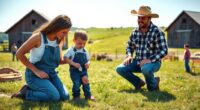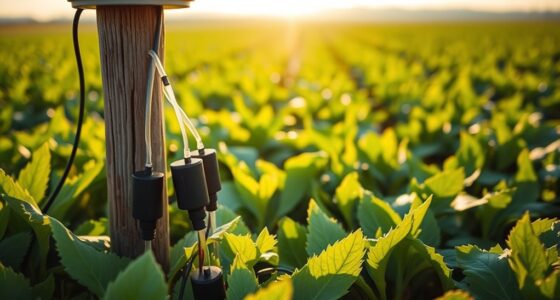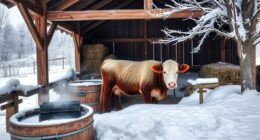To install on-farm renewable energy systems, start by assessing your farm’s energy needs and available resources like sunlight or wind. Explore options such as solar panels, wind turbines, or biomass, and evaluate your site’s layout for ideal placement. Check local regulations and secure necessary permits. Plan your budget to include incentives, then work with professionals for designing and installing your system. Regular monitoring and maintenance will maximize benefits and prepare you for future upgrades—more tips await as you continue.
Key Takeaways
- Assess your farm’s energy needs and available resources to determine suitable renewable system options.
- Design and plan the system by selecting appropriate technologies like solar, wind, or biomass, considering future expansion.
- Research local regulations, zoning laws, and permits to ensure compliance and smooth project approval.
- Choose reliable, certified equipment and carefully plan installation for optimal performance and safety.
- Implement ongoing monitoring and maintenance to optimize energy output and plan for future upgrades.
Assessing Your Farm’s Energy Needs and Resources
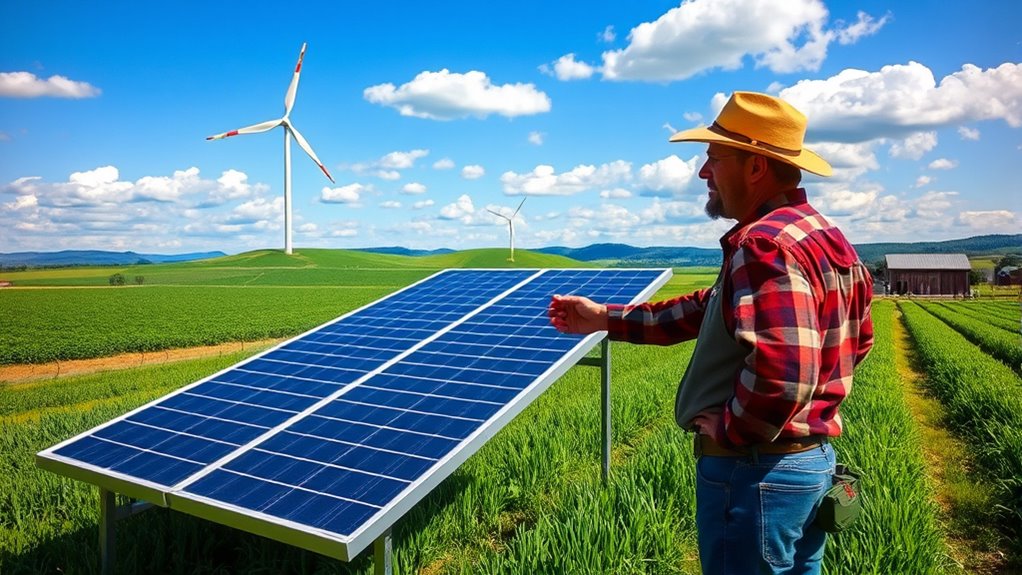
Before installing an on-farm renewable energy system, you need to thoroughly assess your farm’s energy needs and resources. Start by identifying how much energy your farm consumes daily, including electricity for equipment, lighting, and heating. Review past utility bills to pinpoint seasonal variations and peak usage times. Next, evaluate your available resources—solar exposure, wind patterns, or biomass options—based on your location. Conduct a site assessment to determine the best spots for equipment installation and ensure they receive adequate sunlight or wind flow. Consider future growth or changes in your farm’s operations that might influence energy demand. Understanding your energy consumption patterns can help you optimize system design and efficiency. This comprehensive understanding helps you select the most suitable renewable energy technology and design a system that efficiently meets your farm’s current and future energy requirements.
Exploring Different Types of Renewable Energy Technologies
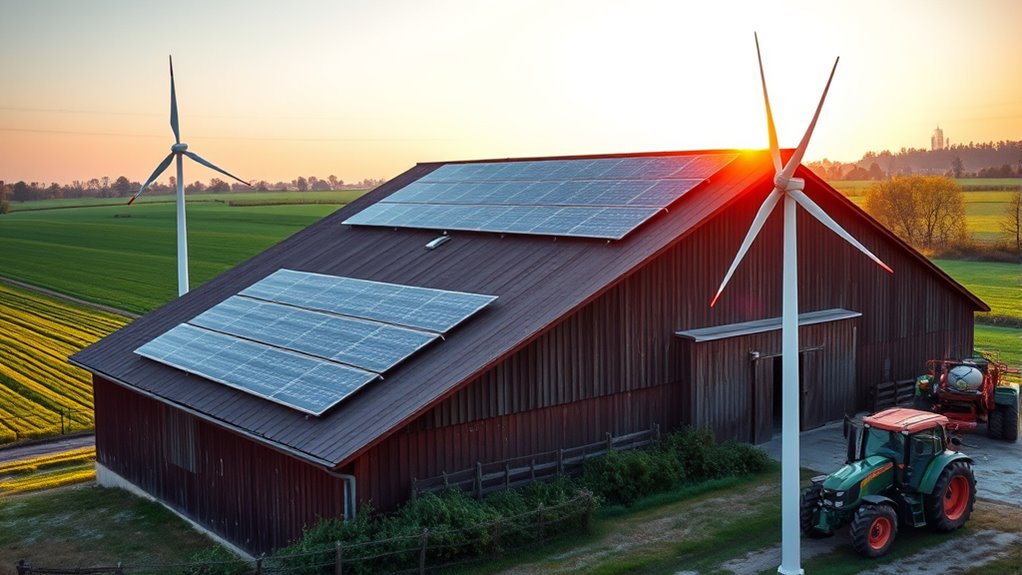
There are several renewable energy options you can consider for your farm, including different types of solar panels, wind turbines, and biomass methods. Each technology has unique advantages depending on your site’s resources and energy needs. Understanding these options helps you choose the most effective systems for your farm’s sustainability goals. For example, selecting the appropriate solar panel technology or wind turbine size can significantly impact energy output and efficiency.
Solar Panel Options
Choosing the right type of solar panel depends on your farm’s specific needs and conditions. Monocrystalline panels are highly efficient and perform well in limited spaces, making them ideal if you have restricted area. Polycrystalline panels are more affordable and slightly less efficient but still suitable for general farm use. Thin-film panels are lightweight, flexible, and better at handling high temperatures, which can be advantageous in hot climates. Consider durability, efficiency, and cost when selecting panels. If space is limited, high-efficiency monocrystalline options might be best. For larger areas, polycrystalline or thin-film panels could be more practical. Also, think about maintenance and lifespan; some panels require less upkeep and last longer. Matching your needs with the right solar panel type guarantees maximum energy production and cost-effectiveness. Effective storytelling can also be used to communicate the benefits of renewable energy systems to stakeholders, increasing buy-in and support.
Wind Turbine Types
Are you aware that different types of wind turbines are designed to suit various farm conditions and energy needs? Horizontal-axis turbines are the most common, featuring blades that rotate around a horizontal hub, ideal for open spaces with consistent wind. They’re efficient and suitable for larger farms aiming for high energy output. Vertical-axis turbines, on the other hand, have blades that rotate around a vertical shaft, making them more adaptable to turbulent or variable wind conditions. They are often simpler to install and maintain, making them suitable for smaller or irregularly shaped farms. Some turbines are designed specifically for low wind speeds, ensuring energy generation even in less windy areas. Understanding turbine efficiency and the factors affecting it can help you make a more informed choice. Choosing the right type depends on your farm’s location, wind patterns, and energy goals.
Biomass Energy Methods
Building on your understanding of wind turbines, biomass energy offers another versatile renewable option for farms. It converts organic material into heat, electricity, or fuel, making use of waste products and dedicated crops. You can use methods like direct combustion, anaerobic digestion, or gasification to generate energy. Each method suits different farm needs and resources, providing flexibility. Biomass systems can reduce waste, lower energy costs, and decrease reliance on fossil fuels. They also promote sustainable farming practices by recycling nutrients and organic matter. As you explore biomass options, consider the scale, feedstock availability, and environmental impact. This approach can help you diversify your energy sources while supporting farm resilience and sustainability. Additionally, biomass energy systems can improve overall farm waste management and reduce greenhouse gas emissions.
Conducting Site Evaluations and Feasibility Studies

Before installing an on-farm renewable energy system, performing thorough site evaluations and feasibility studies is essential. You need to assess factors like sunlight, wind, and water flow to determine the best energy source. Visualize your farm as a grid, with key aspects mapped out:
| Site Feature | Assessment Focus | Potential Impact |
|---|---|---|
| Open fields | Solar access and shading | Affects solar panel efficiency |
| Wind corridors | Wind speed and direction | Influences wind turbine placement |
| Water sources | Flow rate and availability | Important for hydro systems |
| Existing structures | Structural stability and space | Impacts equipment installation |
This process helps identify limitations and opportunities, ensuring your system is efficient and sustainable. Considering the availability of natural resources such as sunlight and wind is vital for optimizing system performance.
Understanding Local Regulations and Permitting Requirements

Finding your way through local regulations and permitting requirements is a crucial step in installing on-farm renewable energy systems, as these rules can greatly influence your project timeline and design options. You’ll need to research zoning laws, building codes, and environmental restrictions specific to your area. Permits may be required for construction, grid interconnection, or environmental impact assessments. Failing to comply can lead to delays, fines, or even project shutdowns. Understanding these requirements early helps you avoid costly surprises. Additionally, reviewing renewable energy policies can provide insights into incentives and restrictions that might impact your project.
Navigating local regulations and permits is essential to keep your on-farm renewable energy project on track and compliant.
- Ensure your system design aligns with zoning restrictions
- Identify permit application procedures and timelines
- Clarify inspection and approval processes
- Recognize environmental impact considerations
- Confirm interconnection standards with utility providers
Planning Your Budget and Securing Funding or Incentives
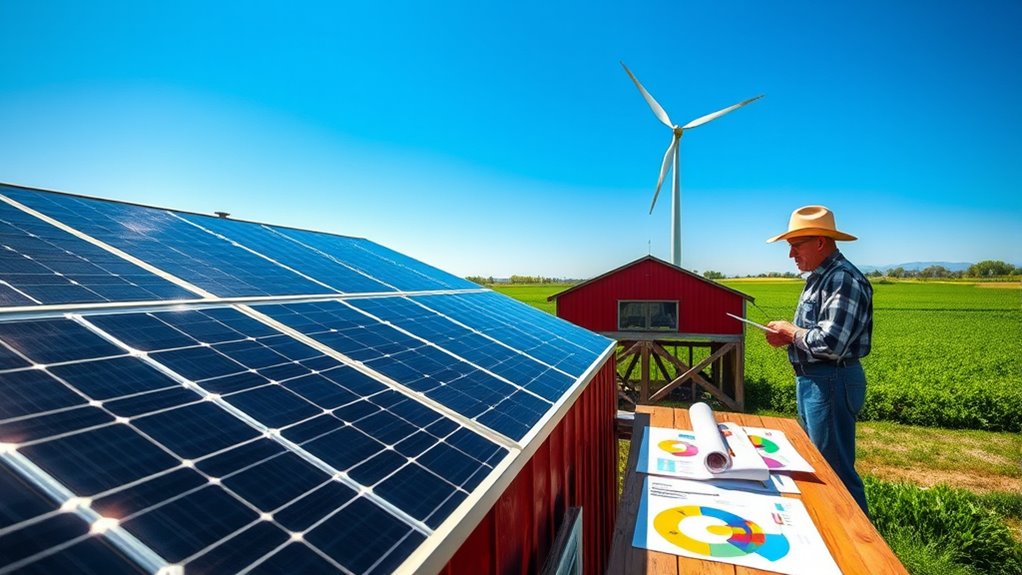
Planning your budget and securing funding or incentives is a critical step that can substantially impact the feasibility and success of your on-farm renewable energy project. Start by estimating total costs, including equipment, installation, and ongoing maintenance. Research available grants, tax credits, and rebates offered by federal, state, or local programs. These incentives can markedly reduce your upfront expenses. Consider exploring low-interest loans or financing options tailored for agricultural projects. Create a detailed budget to identify funding gaps and prioritize expenses. Engage with financial advisors or renewable energy experts to develop a realistic plan. Securing the right funding early helps you avoid delays and ensures your project stays on track. Proper planning and leveraging incentives can make your renewable energy system more affordable and economically viable. Additionally, understanding merchant services and potential financial risks can help you manage payments and safeguard your investment effectively.
Selecting Reliable Equipment and Trusted Suppliers
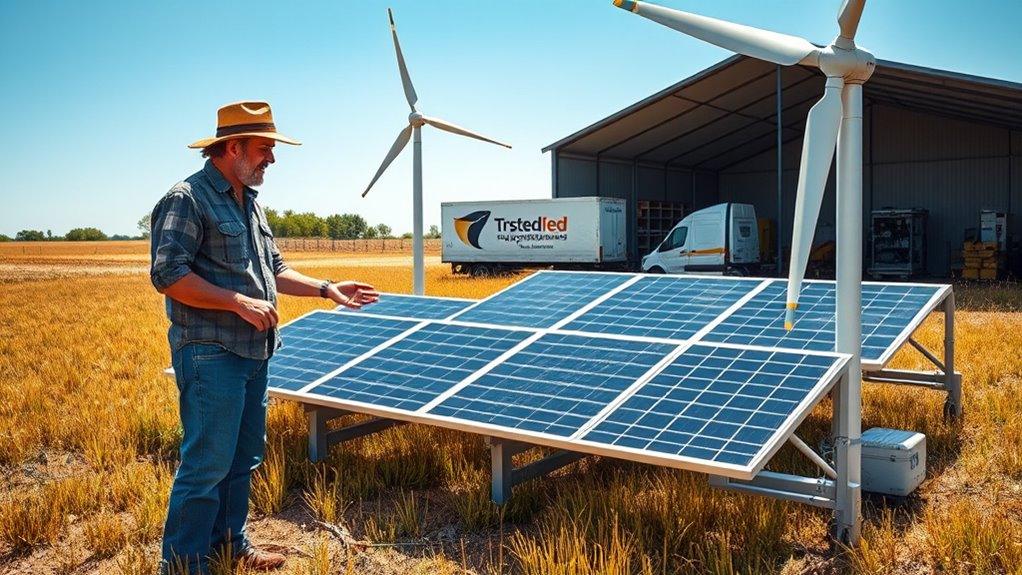
Choosing reliable equipment and trusted suppliers is essential to guarantee your renewable energy system performs efficiently and lasts for years. When selecting components, prioritize quality and durability to avoid costly repairs or replacements. Work with suppliers who have proven track records and positive customer reviews. Verify that the equipment meets industry standards and certifications, ensuring safety and performance. Establish clear communication channels and support services to address issues promptly. Remember, investing in reputable brands and trustworthy partners minimizes risks and maximizes your system’s lifespan. Additionally, considering the emotional alignment of your choices can help ensure a smoother installation process and more positive ongoing experiences.
Designing a Custom System for Your Farm’s Layout

To create a system that fits your farm perfectly, start by evaluating your space needs and available land. Consider how to position equipment for peak efficiency and easy maintenance. Using practical layout tips can help you design a custom setup that maximizes energy output and minimizes space conflicts. Incorporating sustainable design principles ensures your renewable energy system aligns with eco-friendly practices and optimizes resource use.
Assessing Farm Space Needs
Before designing your renewable energy system, you need to accurately assess the space available on your farm. This ensures your system fits well without disrupting daily operations. Measure the area where you plan to install equipment, considering both current needs and future expansion. Take note of obstacles like trees, buildings, or uneven terrain that could impact placement. Evaluate sunlight exposure and wind patterns to optimize energy production. Also, check local regulations or setbacks for installation zones. Understanding your space helps you choose the right system size and layout.
- Identify suitable locations that maximize sunlight and wind resources
- Consider future farm growth or additional equipment needs
- Account for accessibility for maintenance and repairs
- Minimize interference with existing farm activities
- Ensure safety distances from livestock and structures
Custom System Layout Tips
Designing a custom system layout begins with understanding your farm’s unique topography, existing structures, and operational flow. Map out the land to identify ideal locations for equipment, considering sun exposure, wind patterns, and shading from trees or buildings. Position solar panels where they’ll receive maximum sunlight, and place wind turbines where wind speeds are highest and obstacles are minimal. Keep access routes clear for maintenance and emergency access, and plan for future expansion. Consider proximity to existing electrical infrastructure to minimize wiring costs. Integrate your renewable system seamlessly with your daily operations to avoid disruptions. Use this understanding to create a detailed layout that maximizes efficiency, reduces costs, and aligns with your farm’s specific needs. Proper planning ensures your renewable system performs reliably and effectively.
Installing and Connecting Your Renewable Energy System

Once you have selected the appropriate location and equipment for your renewable energy system, the next step is to carefully install and connect all components. Guarantee your mounting structures are secure and level to maximize efficiency. Follow manufacturer instructions for wiring and positioning of solar panels or turbines, avoiding shading and obstructions. When connecting components, double-check all connections for tightness and correct polarity to prevent faults. Use proper grounding techniques to ensure safety and system longevity. Test each connection thoroughly before powering up the system. Remember, precise installation minimizes future maintenance and maximizes energy output.
- Confirm all connections are secure and correctly wired
- Ensure proper grounding for safety and performance
- Avoid shading or obstructions that reduce efficiency
- Follow manufacturer instructions meticulously
- Test system components before final power-up
Monitoring System Performance and Maintenance Tips

To keep your renewable energy system running smoothly, you need to regularly monitor its performance. Using simple tracking techniques helps you spot issues early and make sure you’re getting the expected output. Following maintenance best practices will help extend the lifespan of your system and maximize its efficiency.
Performance Tracking Techniques
Effective performance tracking is essential to guarantee your on-farm renewable energy systems operate at peak efficiency. Regular monitoring helps identify issues early, optimize output, and extend system lifespan. To do this effectively, track key metrics like energy production, system uptime, and component performance. Use data logging tools and digital dashboards to visualize trends over time. Set benchmarks based on manufacturer specs and historical data, and compare real-time performance against these standards. Keep detailed records of system behavior to spot patterns and detect anomalies quickly. Remember, proactive tracking minimizes downtime and avoids costly repairs.
- Focus on critical performance indicators
- Use reliable monitoring tools
- Schedule regular data reviews
- Establish baseline performance standards
- Document all observations and adjustments
Maintenance Best Practices
Regularly monitoring your renewable energy system’s performance is essential for maintaining peak operation and preventing costly issues. Keep an eye on key indicators like energy output, system temperatures, and inverter status. Schedule routine inspections to identify wear, corrosion, or loose connections early. Clean components such as panels and filters to optimize efficiency. Use the following table as a quick reference for maintenance tips:
| Maintenance Task | Frequency | Purpose |
|---|---|---|
| Check system readings | Weekly | Detect early performance drops |
| Inspect for physical damage | Monthly | Prevent component failure |
| Clean panels and filters | Quarterly | Maximize energy absorption |
Maximizing Benefits and Planning for Future Expansion

Maximizing the benefits of your on-farm renewable energy systems requires careful planning and ongoing evaluation. You should regularly review your energy production and consumption patterns to identify opportunities for increased efficiency. Consider future expansion early on by designing systems that can be scaled or upgraded as your needs grow. Evaluate potential new technologies or additional renewable sources to diversify your energy portfolio. Keep an eye on financial incentives and evolving policies that could enhance your return on investment. Collaborate with experts to develop a long-term energy plan that aligns with your farm’s goals.
- Assess your current energy needs periodically
- Design for scalability and upgrades
- Stay informed about policy changes and incentives
- Explore complementary renewable options
- Involve professionals for strategic planning
Frequently Asked Questions
How Long Does It Typically Take to Install a Farm Renewable Energy System?
It typically takes anywhere from a few weeks to a few months to install a farm renewable energy system. The timeline depends on the system’s size, complexity, and permitting processes. You’ll need time for planning, obtaining permits, and installation. If you work with experienced installers, they can streamline the process, helping you get your system up and running quickly. Be prepared for some variability based on your specific farm and location.
What Are Common Challenges Faced During Installation and How to Overcome Them?
Did you know that 65% of farm installations face delays due to permitting issues? During installation, common challenges include limited space, equipment logistics, and grid connection delays. To overcome these, plan thoroughly, coordinate with local authorities early, and guarantee your site is optimized for equipment placement. Keeping communication open with contractors and utility providers helps avoid surprises, ensuring your renewable energy system gets installed smoothly and on time.
Can I Operate My Farm’s Renewable System During Power Outages?
Yes, you can operate your farm’s renewable system during power outages if you have a properly installed backup system like a generator or battery storage. Make certain your system is configured with automatic transfer switches and backup power sources. Regularly maintain and test your backup setup to guarantee it functions when needed. This way, your farm stays productive and protected even during outages.
What Maintenance Skills Are Needed to Keep the System Running Efficiently?
You need basic maintenance skills like inspecting panels or turbines regularly, cleaning dust or debris, and checking connections for corrosion or damage. You should also understand how to monitor system performance, troubleshoot issues, and perform simple repairs or replacements of parts like fuses or filters. Familiarity with safety procedures is essential to prevent accidents. Keeping detailed maintenance records helps guarantee your system runs efficiently and extends its lifespan.
How Do Seasonal Weather Changes Affect System Performance and Longevity?
Seasonal weather changes can impact your system’s performance and lifespan. Cold winters may cause components to freeze or become brittle, reducing efficiency, while hot summers can lead to overheating or accelerated wear. Heavy rain or snow might cause physical damage or corrosion if not properly protected. To keep your system running smoothly year-round, you should regularly inspect, clean, and protect it against weather extremes, ensuring longevity and maximum energy production.
Conclusion
By taking these steps, you can confidently harness renewable energy on your farm, reducing costs and environmental impact. Some believe that embracing green tech instantly transforms farms into sustainable models—while it’s true that effort and planning are essential, the real power lies in your commitment. When you invest in renewable systems, you’re not just saving money; you’re helping create a healthier planet for future generations. Your farm’s energy future starts now—embrace it.


